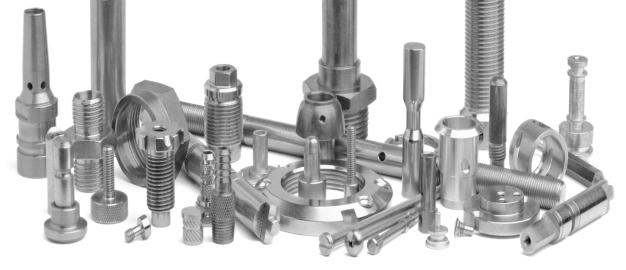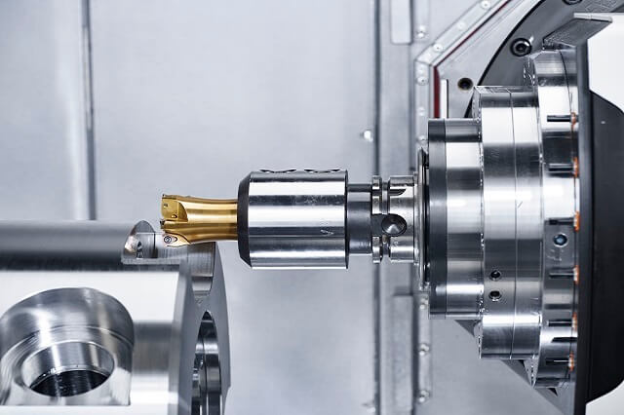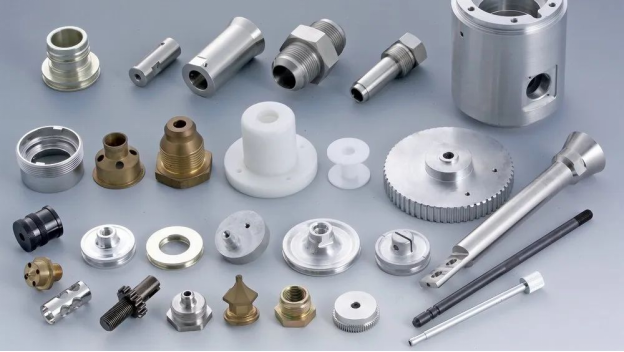What Is Precision Turned Parts? -An A-Z Guide
 Feb 12,2025
Feb 12,2025

We know you will have a clue through this heading “What are precision-turned parts”. There are two words which are helpful to understand what is about this article. Precision means the parts with tight tolerance, surface finish etc. are great. Turned parts mean that the parts are manufactured through the turning process. So, this article is about the precision of parts manufactured using turning operation.

Definition and Meaning of Precision Turned Parts
An introductory section of this interesting article:
What is Precision Machining?
The precision means that the dimensions of the parts are 99% the same as required, and the parts contain tight tolerance. Precision Machining involves that the parts contain all the properties such as roughness surface, surface finish, dimensional accuracy etc. Precision Machining means different machining methods such as milling, drilling, turning and many more. These methods use multiple cutters to turn a workpiece into the ultimate desired shape. Advanced machines like CNC are the reason we see aeroplanes, advanced cars etc. in daily life.
Precision Turned Parts vs. General Turned Parts
Precision and general turning, both are the same processes performed on Lath and CNC machines. The only difference is the level of accuracy and achieved tolerance.
Key Characteristics of Precision Turned Parts
- You can achieve tight tolerances
- It is easy to machine complex geometries
- Excellent surface finish
- You can use it for any material
How Precision Machined Parts Benefit Industries
When the machined parts have 100% accurate dimensions and excellent surface finish and roughness, then the failure rate is lower. If the failure rate is lower it means material and money waste is less, which is economically beneficial to industries and companies. A precision machined part has a longer life than a general machined part, so it is more reliable at any level.
The Process of Making Precision-Turned Parts

Till now, we have been discussing general precision Machining which can be about milling or drilling etc. In this section, we are specifically focusing precision precision-turned parts.
Overview of the Precision Turning Process
The general working mechanism of the precision turning process is that the workpiece rotates against a stationary cutting tool. But in detail, the process involves:
- Mounting of the workpiece on a lathe machine
- Select the appropriate cutting tools
- Inspect both the workpiece and the cutting tool, before you start the operation
- Choose an optimum cutting speed and feed rate
- Turning can be manual or automatic. In the case of CNC machines, the turning process is easy to use for precision machining of the parts due to its automation feature.
- To create small and intricate parts, use the Swiss machine.
CNC Turning: Key Technology in Precision Manufacturing
In the above section, I mentioned the usage of CNC machines for precision-turned parts. Let's see why:
- CNC stands for Computer Numerical Controlled machine, which means it is controlled through a computer more specifically through a CNC program. In CNC machines, we set the required or optimum speeds, feed rates etc. then it works by itself like no human labour is required to operate it manually.
- If we talk about the role of CNC programming in precision Machining, it stands with the most important use. Due to programming, the CNC machine tools follow design parameters etc. by themselves during material removal.
- Due to the automation features of the CNC machine, high-quality products with complex geometries can produced.
Swiss Screw Machining: A High-Precision Turning Process
- Fast production rate
- No tools wear during operation, so high dimensional accuracy
The material waste is lower, efficient material usage.
Swiss Machines vs. CNC Machines for Precision Turned Components
- Swiss Machines are especially designed for small, intricate components
- Fast production rate
- Used to produce large volumes of components
CNC machines
- Used for medium to large-size components
- The production rate is relatively slower
Precision Turned Parts List
This section provides information related to different types of turned parts of different materials.

Small Precision Turned Parts
Micro-fasteners, small bushings precision fittings etc. are produced through Swiss Machines.
Steel Turned Parts
Due to high-strength properties, steel-turned components are used in heavy machinery, automotive manufacturing and construction industries.
Aluminum Turning Parts
Lightweight, good strength, conductivity and corrosion resistance Al turned parts are used in electronics and aerospace industries.
CNC Precision Turned Components
The turning process can be used manually but on a CNC machine, precision turning is possible. This machine manufactures components according to critical standards.
Examples of Precision-Turned Components in Various Industries
Let us present some examples of precision-turned components in this section.
Automotive Applications: Engine Components, Pins, and Bushings
Some of the main parts of a vehicle include engine valves and bushings. These components are produced using precision turning.
Aerospace: Structural Parts and Fasteners
- Ti bolts and screws
- landing gear pins & bushings
- Actuator shafts
- Gyroscope and sensor housings
Medical Devices: Surgical Tools and Implants
- Bone drills and taps
- Needle holders
- Retractors
- Bone screws and plates
- Dental implants
- Spinal rods
Electronics and Consumer Goods: Fittings and Connectors
- PCB Standoffs & Spacers
- Micro screws and pins
- Optical fiber connectors
- Headphone jacks
- Camera lens mounts
Turned Part Materials
Materials like steel, brass copper, TO etc. are used in almost every industry, that's why these materials are machined using a turning operation.
Steel Turned Parts: Durability and Strength
Steel is durable and provides high strength underload, that's why it is used in every industry, i.e. construction of electronics.
Brass and Copper: Ideal for Low Friction Components
Brass and Cu have lower friction properties due to which, these materials are used in plumbing fittings and electrical connectors applications respectively.
Titanium and Other High-Performance Alloys
Ti shows the best mechanical properties regardless of the environment and load which makes it preferable for aerospace and medical applications.
Aluminium: Lightweight Precision Components
Al is lightweight and a good conductor of electricity and shows excellent corrosion resistance which is why it is used where weight reduction is important.
Choosing Materials for High-Volume Precision Turned Parts
You can't just randomly select any material for high-volume production, but it depends on the application, mechanical properties and cost considerations.
Tailoring Materials for Precision CNC Turned Parts
Yes, you can choose the alternative materials if it is hard to find exactly the required material for precision turning. You can use further heat treatment processes to alter the mechanical properties of the selected material.
Benefits of Custom Precision Turned Parts
That is why custom precision-turned parts are beneficial:
High Accuracy and Tight Tolerances
The parts which require a tight tolerance and higher accuracy are mostly machined using custom turning.
Cost-Effectiveness in Large-Volume Manufacturing
The customization of precision-turned parts increases the production rate hence reducing the costs per unit.
Versatility in Customization
- You can customise your part according to your requirements easily
- CNC is an advanced machine which reduces post-production alterations as well
- Custom-turned parts can be used for any industry, increasing product performance
Quick Turnaround and Efficient Production
Precision turning uses streamlined operations, enhancing prototyping and reducing production cycles. These streamlined operations make a possible quick turnaround and efficient production.
Durability and Long-Term Performance
In precision turning, the parts are manufactured carefully so reducing the surface defects up to 99%. The parts with the lowest surface defects are durable and used for long-term performances.
Challenges of High-Volume Precision Turning
You can face one of the following challenges during high-volume precision turning:
- Maintaining consistency
- Management of tools wear
- Difficult to meet Quality standards
How to Choose the Right Precision Turned Parts Manufacturer
You should consider the following criteria before you choose a precision-turned parts manufacturer:
Considerations in Selecting a Turned Parts Manufacturer
Two important things you should note before giving an order to any manufacturer:
- Analyze if that respective person has experience with high-volume precision turned parts.
- Second, you should see that does respective person has certifications and quality control in CNC precision turning.
Factors to Evaluate in CNC Turning Parts Manufacturers
- Along with certifications and experience in high-volume precision tuning parts manufacturers, the following things are important to consider as well.
- See whether this manufacturer has the required machines like for precision tuning CNC machines are preferable to manual machines.
- Check if the manufacturer can also provide you with post-turning facilities such as grinding or milling etc.
Turned Parts Supplier vs. Manufacturer of Turned Components
A Manufacturer is equipped with machines, so he has better control over matching the turned parts. On the other hand, A supplier is a person who just distributes turned parts.
What Sets High-Volume Precision Turned Parts Manufacturers Apart?
It is difficult to maintain consistency in quality in bulk production, but these manufacturers do it easily. They are experienced in bulk production with cost-effective and time-saving methods.
Secondary Processes in Precision Turning
Post-turning operations are important to perform to make components more durable and reliable.
Secondary Turning Parts: Adding Value Beyond the Initial Turn
Secondary operations like polishing, heat treatment etc. are performed right after the precision turning to remove any surface flaws etc. and to make them more durable.
Polishing and Finishing of Precision Turned Parts
To make surfaces smoother and to make an aesthetic look, polishing is done after the turning process.
Coatings and Heat Treatment for Enhanced Durability
- Heat treatments are used to change grain size i.e. changing microstructure, which ultimately enhances mechanical properties by making parts more durable.
- The coating helps prevent oxidation during usage at high temperatures.
Value-Added Services Offered by Precision Turned Parts Suppliers
Precision-turned parts suppliers can offer Quality inspection & 3D testing, Surface Treatments and Coatings, Secondary machining and finishing etc.
Quality Control and Inspection
Some methods are used to make sure that the components follow the critical standards. These methods include optical & laser scanning, Non-destructive testing, hardness and surface roughness tests, material certifications and traceability tests etc.
Customization of Precision-Turned Parts for Specific Applications
Some common examples of customized precision-turned parts are precision shafts, surgical implants, fuel injection nozzles, custom bushings, spacers etc.
Finding a Reliable Precision Turned Parts Supplier
Sometimes it is very difficult to physically find a reliable precision-turned-parts supplier. In this regard, the internet might help you.
Online Resources for Finding Parts Manufacturers
Now suppliers post their achievements on the internet. You can find online whether that supplier has advanced machinery or not. You can see an example of multiple suppliers in the following table:
|
Feature |
TUOFA Precision Machining |
Swiss Technologies Inc. |
XYZ Precision Components |
Apex Engineering |
|
Material Capabilities |
Stainless Steel, Aluminum, Titanium, Brass |
Stainless Steel, Copper, Plastics |
Aluminum, Steel, Inconel |
Stainless Steel, Bronze, Copper |
|
Max Diameter |
100 mm |
80 mm |
75 mm |
90 mm |
|
Min Part Diameter |
2 mm |
3 mm |
4 mm |
5 mm |
|
Tolerance Level |
±0.002 mm |
±0.005 mm |
±0.010 mm |
±0.003 mm |
|
Surface Finish |
Polishing, Anodizing, Powder Coating |
Chrome Plating, Electroplating |
Sandblasting, Brushed Finish |
Nickel Plating, Passivation |
|
Production Volume |
Small to High (10-500,000 pcs) |
Small to Medium (5-50,000 pcs) |
High Volume (100,000+ pcs) |
Small Batch (1,000-10,000 pcs) |
|
CNC Machining Capability |
3-axis, 5-axis CNC |
4-axis CNC, Swiss Turning |
3-axis, 4-axis CNC |
5-axis CNC, Swiss Turning |
|
Lead Time |
2-3 weeks |
4-5 weeks |
3-6 weeks |
2-4 weeks |
|
Certifications |
ISO 9001, AS9100 |
ISO 13485, IATF 16949 |
ISO 9001, ITAR |
AS9100, ISO 14001 |
Local vs. International Turned Parts Suppliers
For quick transportation of materials or tuned parts, local supplies are preferable but international turned parts suppliers are preferable if cost-saving is the primary focus.
How to Verify a CNC-Turned Parts Manufacturer's Capabilities
- First, consider their machines
- Check their certifications and compliances
- Review past projects and case studies
- Assess quality control processes
- Get a sample prototype
Conclusion
We conclude that the precision-turned parts are important components of our daily life machines. You can use manual or CNC machines to produce turned components depending on the applications. In general, Swiss machines are used to machine small, intricate parts while CNC machines are used for bigger components. You should analyze the technical and other related capabilities of a manufacturer before you select a manufacturer.
How Tuofa China Turned Parts Supplier Supports Your Manufacturing Needs
Toufa is a China-based company which is equipped with the most advanced turning machines. We stand with the best CNC operators who will produce the parts with tight tolerances and deliver the products in a short time. Toufa will make your required components of high precision, maintaining high quality in mass production as well.
 Tel/WeChat:
Tel/WeChat:  Email:
Email: 
 Home
Home
 Turning vs Boring: Differences and Applications in Machining
Turning vs Boring: Differences and Applications in Machining 







